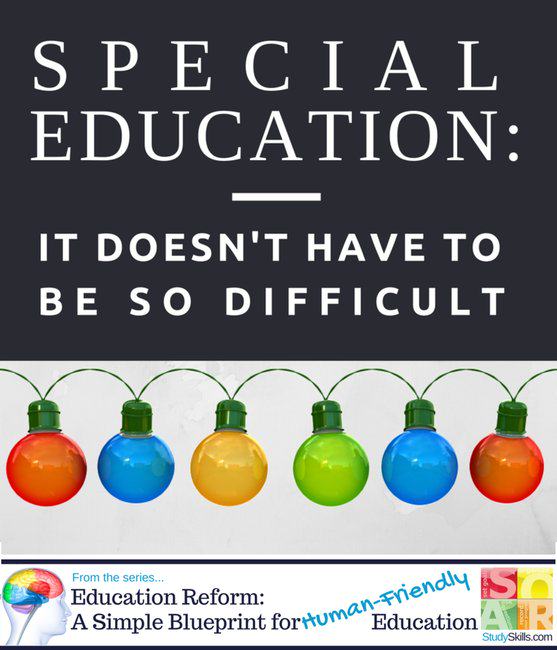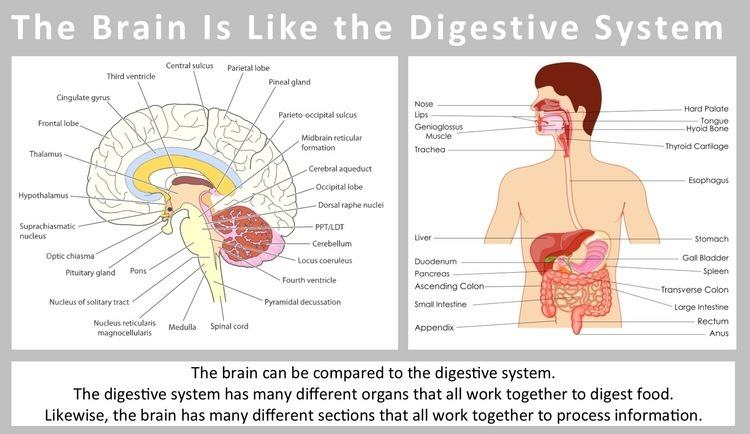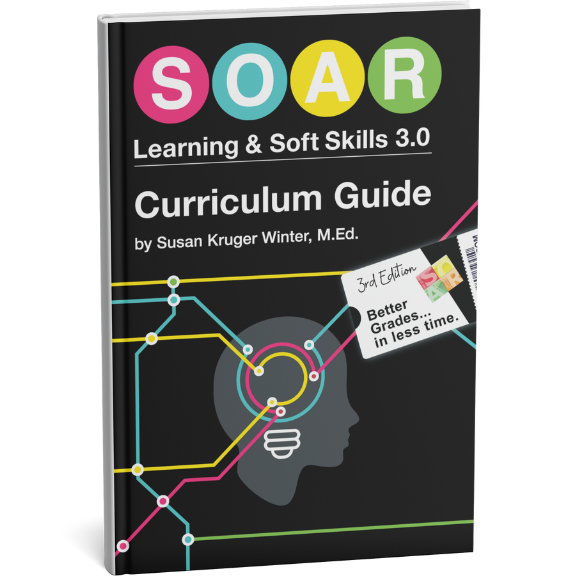Special Education: It Doesn’t Have to Be So Difficult
This article is from our series, Education Reform: A Simple Blueprint for Human-Friendly Education. For a directory of all articles in this series, click here. To get the full series in one downloadable PDF, sign-up for the free report in the black box on the right.

Do students have learning disabilities? Or, does our system have a teaching disability?
Maria Montessori taught children labeled as “uneducable” and “idiots” to surpass their normal peers on standardized tests. My own son was diagnosed with “severe dyslexia” as a first-grader. We moved him to a Montessori school; within nine months, he was reading “on level” with no additional intervention.
Don’t get me wrong, I am not criticizing special education teachers. Special ed teachers are the most dedicated and compassionate educators I meet!
But, special education teachers and students are both stuck in a flawed system. A system that finds it easier to slap a label on students –telling them something is wrong with them– than to teach everybody correctly from the beginning.
Nearly 50% of today’s special education students have been diagnosed with learning disabilities.1 These so-called “disabilities” are largely a result of our failure to teach according to human development. We are totally ignorant of the brain biology of learning and millions of students are needlessly suffering.
What is a learning disability? Before we can truly understand learning disabilities, we must understand how the brain is designed.
Most people don’t really understand how learning disabilities work. Most “experts” don’t even understand the brain biology of these conditions; they are experts only in the symptoms of the conditions. That may be helpful, but it leaves a lot of room for guessing about solutions.
A simple understanding of how the brain works can provide incredible clarity…
How Our Brains Work
As described in a previous article, The Brain Biology of Learning: Why the Success Pyramid Works, our brains have three major regions that govern the learning process. These sections are responsible for different types of functions, such as:
- The Emotional Center of the brain processes emotions and monitors for safety threats.
- The Front Brain collects all information from our five senses, interprets what all of those signals mean, then makes decisions about how to respond to them.
- The Back Brain processes all learning and problem-solving.
Within each of these sections, there are smaller, more specialized sections that process: movement, language, visual input, music, logical information, intuitive information, etc.
The information that follow digs a bit deeper into how these sections communicate with one another.
Our Brain Is Like Our Digestive System: Many Sections to Serve One Function
The brain is not ONE organ; it’s a collection of many different sections that work together to process a wide variety of information. Just like our digestive system.
We all know that the stomach has a different function from the liver. Which has a different function from the small intestine. Which has a different function from the large intestine.
Yet, all of these different organs work together to accomplish one function: digesting food. Likewise, the brain also has multiple different sections with different functions. The Parietal lobe has a different function from the Cerebullum. Which has a different function from the Thalamus.
But, all of these sections work together in the brain to accomplish one function: processing information.
The Brain Is an Electrical Organ
Just like your toaster, your brain runs on electricity. This electricity is powered by chemicals in your brain, such as: norepinephrine, dopamine, serotonin, and many others. In fact, you brain is nothing more than a collection of electrical wires called neurons.
You have over 100 billion neuron wires in your brain! It’s an extraordinarily complex arrangement of wires. Yet, it’s an extraordinarily simple system, too. Each one of those neuron wires works just like this string of party lights.

Yet, each one of those neuron wires works just like this string of party lights.
In the brain, signals of electricity travel along each circuit to different sections. When a signal reaches its destination, a connection is made and information is processed.
The same is true with a string of party lights. When the signals of electricity reach each bulb, a connection is made and the bulb illuminates.
As you know, when you plug in a string of lights, every bulb lights up instantly, even though each bulb is receiving a separate signal. This is how the wires in your brain work, firing connections across different regions of the brain faster than the speed of light.
For example, when you watch a movie, different regions of your brain actively collect various visual, language, musical, and setting cues. In fractions of a second, these different regions collect information, process it, and share it with each other to help you make sense of the movie.
The Brain Biology of Learning Disabilities
Learning disabilities are nothing more or less than weak neuron signals between specific sections of the brain. These sections of the brain have a reduced amount of brain chemicals that power neuron connections. As a result, these sections have a reduced capacity to manage the specific function each was designed to do.
For example, a student with dyslexia likely has a couple of sections of the brain with a reduced amount of brain chemicals. One of these sections might processes language. Another section might process symbols (such as letters). With reduced levels of brain chemicals, these sections send and receive fewer signals across neuron wires.
By definition, a learning disability is limited to only one or two sections of the brain. Otherwise, the diagnosis is a more comprehensive cognitive impairment.
Unfortunately, we don’t yet have the scientific tools to measure brain chemicals and activity in every individual student. However, it is important for students to understand that these challenges are limited to just a couple of very small areas within a much larger –and stronger– brain.
We can help them use their strengths to build detours around their challenges. In part 2 of our 3-part series on education, we’ll explore how to build these detours, when we look at How to Solve & Prevent Learning Disabilities.
To our students’ success,
Susan Kruger, M.Ed.
Students with Intensive Physical and/or Cognitive Impairments
Approximately half of all special education students have physical and cognitive impairments requiring more intensive therapies and/or interventions beyond the Success Pyramid model.
HOWEVER, the Success Pyramid model is still core to achieving success with these students. Complete Human Education is just as important for their ability to grow and be the best version of themselves as possible. They will only be able to reach their full potential when we educate them according to our shared basic needs as human beings, as modeled in the Success Pyramid.
Education Reform: A Simple Blueprint for Human-Friendly Education
This article is from our full report on education reform. Portions of the report will be released on a weekly basis in article form (see the directory below).
However, to access the full report (in its entirety) now, sign-up in the black box on the right.
Education Reform Article Directory:
- Introduction to Education Reform: A Simple Blueprint for Human-Friendly Education
- Three Core Problems with Education in the United States
- The Success Pyramid: A Model of Effective & Efficient Learning
- The Brain Biology of Learning: Why the Success Pyramid Works
- Solutions for Core Problem #1 with Education in the United States
Solutions for Core Problem #2 with Education in the United States
Solutions for Core Problem #3 with Education in the United States - Special Education: It Doesn't Have to Be So Difficult - Part I of III
Special Education: How to Solve & Prevent Learning Disabilities - Part II of III
Special Education: The Brain Biology of ADHD & Autism - Part III of III - Ideal Instructional Models: Successful Examples of Complete Human Education
- Finland: A Political Model of Education Reform
- Why Common Core Is the Worst & BEST Thing to Happen to Education
- The Simplest Leverage Points in Reading, Math, & Skills Instruction
- Looking Forward: Advice from a Futurist
- Conclusion: The Four Principles of Optimal Instruction
- Summary: An Ideal School System
SPECIAL REPORT: To get the full series in one downloadable PDF, sign-up for the free report in the black box on this page.

Sources
1 – https://www.ncld.org/wp-content/uploads/2014/11/2014-State-of-LD.pdf
Six Steps
Conquer the Chaos
Get Our Free Guide & Information on...

"*" indicates required fields
Get Our FREE Curriculum Guide!
The SOAR® Curriculum
The most critical learning, organizing, and communication skills needed for school. Learn more here.
Who’s Using SOAR®?
SOAR® Guarantee
Click here to learn more.






